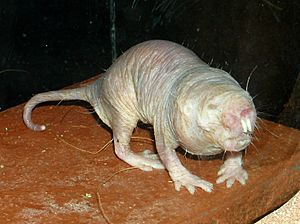Eusociality facts for kids
Eusociality is a special way some animals live together in a highly organized group. It's like a super-team where everyone has a specific job to help the whole group survive and grow.
Contents
What is Eusociality?
Eusociality means a group of animals has a very complex social life. Here are the main things that make a group eusocial:
- They live together in a colony.
- They have different jobs, called a "division of labor." For example, some animals are responsible for reproduction, while others are workers or soldiers.
- They take care of their young together.
- Multiple generations of adults live at the same time and help each other.
A key part of eusociality is that some members of the group, like workers or soldiers, are often sterile. This means they cannot have their own offspring. Instead, they spend their lives helping the reproductive members, like the queen, have and raise young. This is a very strong form of helping family members, sometimes called kin altruism.
Animals That Live Eusocially
The most well-known examples of eusocial animals are insects.
Eusocial Insects
Many insects live in eusocial colonies:
In these insect colonies, there is usually one or a few queens who lay all the eggs. The other members, like worker ants or bees, gather food, build the nest, and protect the colony. Soldier termites, for example, have special body shapes to defend their home.
Eusocial Mammals
There are only two known mammal species that are truly eusocial:
- The naked mole rat
- The Damaraland mole rat
Naked mole rats live in large colonies, often with 75-80 individuals. They dig huge tunnel systems in the dry African deserts. Like insects, they have a queen who is the only one to reproduce, and many workers who dig tunnels and find food.
Other Eusocial Animals
Eusociality is also found in some other animal groups:
- Some types of aphids (tiny plant-sucking insects) and thrips (even tinier insects). These species often live inside plant galls (lumps on plants) and have sterile soldiers that are clones of the reproducing female.
- Certain crustaceans, like some species of Synalpheus pistol shrimp. These shrimp live in sponges on tropical reefs. They have one breeding female and male defenders with large claws.
Why Do Animals Live This Way?
It might seem strange that some animals don't have their own babies and instead help others. How could this behavior evolve? Charles Darwin, who developed the theory of evolution, found this a big puzzle. He thought the answer might be in how closely related the animals are.
Later, scientists developed ideas like inclusive fitness and kin selection to explain this. These ideas suggest that even if an animal doesn't have its own offspring, it can still pass on its genes by helping close relatives reproduce. If its relatives share many of its genes, then helping them is like helping its own genes survive.
Haplodiploidy and "Supersisters"
A special way of determining sex, called haplodiploidy, is found in many eusocial insects like bees, ants, and wasps.
- In this system, females develop from fertilized eggs and have two sets of chromosomes.
- Males develop from unfertilized eggs and have only one set of chromosomes.
This unique system means that sisters in these groups are very closely related. They share about 75% of their genes, which is more than they would share with their own offspring (who would only share 50% of their genes). Because of this, scientists like W.D. Hamilton suggested that it's often better for a worker bee or ant to help her "supersisters" (the queen's offspring) than to try to have her own babies. By helping her sisters, she helps more of her own genes get passed on.
This idea helps explain why eusociality has evolved many times in ants, bees, and wasps. Even in animals that are not haplodiploid, like termites or mole rats, high levels of inbreeding (mating between close relatives) can also lead to colony members sharing many genes, making eusociality more likely to evolve.
Scientists also think about how groups compete with each other. If many eusocial colonies are competing for resources, it can make individuals even more likely to work together perfectly within their own group, acting like one big "superorganism."
Related pages
Images for kids
-
Co-operative brood rearing, seen here in honeybees, is a condition of eusociality.
-
Weaver ants, here collaborating to pull nest leaves together, can be considered eusocial, as they have a permanent division of labor.
-
A swarming meat-eater ant colony
See also
 In Spanish: Eusocialidad para niños
In Spanish: Eusocialidad para niños





